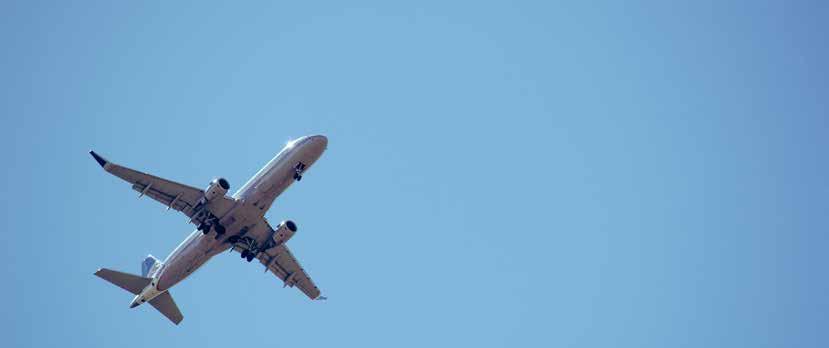
4 minute read
Background, objectives and scope
its development is the strategic application and understanding of how the technology, the industry and its ecosystem will evolve and grow into the future. How do we imagine air taxis integrating with crewed jets and aviation? How do we balance the needs of the existing aviation industry with those of the emerging innovators?
A different approach is critical going forward. In recent years, an unimagined level of digisation has been achieved, accelerated by the impact of COVID-19. This kind of accelerated digisation can, in the future, be expected in aviation.
Advertisement
Tom Verbruggen, Co-founder and CEO of Aviatize, Belgium
What the drone industry is doing is shaking up how an industry evolves – which is as much technology-led as taking into account the regulatory environment, the established ways of thinking about and approaching industry development.
Drones are forcing the aviation industry – known for its adherence to standard operating procedures, rules, safety regulations and strict compliance elements – to re-examine the digitisation of aviation.
Imagine a mega-liner taking off at South Africa’s largest airport, OR Tambo International Airport. As Craig Poultney, a Tower Controller, says, “We can’t have a situation where we say, ‘Turn to your right, but watch out for that drone.’” Poultney continues, “I think one of our biggest challenges is the fact that [the drone industry] is growing so fast.” Drones are here to stay and how they integrate into the airspace – safely, securely and effectively – will be decisive going forward.
An important consideration in the integration of drones into crewed airspaces, regulated and unregulated, is the framework against which this development needs to take place.
According to www.globenewswire.com, on 15 August 2022, the global market for UTM is estimated at
US$791.2 MILLION IN 2022 AND IS PROJECTED TO GROW TO US$1.6 BILLION BY 2026.
An exciting opportunity exists to build a new industry in South Africa – one that can create new businesses, revitalise the aviation industry, and create jobs and opportunities for entrepreneurs to develop new solutions in this tech space. Managing this space will require sophisticated interventions – in terms of the strategic alignment of the airspace, both on the ground and in the air, as well as in the drones themselves and the ancillary systems to support the integration of commercial, regular and automated BVLOS operations.
New UTM software developments offer a multitude of opportunities for software developers to create platforms to support multiple systems that can perform a variety of tasks for both crewed and uncrewed traffic, realtime tracking of drones flying in the air, new ways to illustrate different types of airspace that allow for pilots, drone flight managers and others to better manage the aircraft in this airspace.
Taking advantage of these opportunities and building an integrated aviation landscape in South Africa means understanding the UTM landscape and ecosystem, which are imperative next steps in developing the potential of the drone industry.
03
About the UTM landscape in South Africa
The UTM landscape begins first in the aviation space. Aviation being a highly technical, legislative and complex industry, when it comes to UTM the aviation challenges are the most critical element to address. Safety and security are tantamount in this industry – the risk of drones running into jets is real, and the ability to safely manage the airspace in which both will operate is important.
Following are the aviation challenges that are of interest in South Africa, the first being the monitoring and management of Remote Piloted Aircraft Systems (RPAS), and the second being the deployment of an enabling Uncrewed Traffic Management System, otherwise known as a UTM, in South Africa’s airspace.
The major challenge for the South African Civil Aviation Authority (SACAA) is that UAS/RPAS flown in the South African airspace are not all registered to their owners.
When an RPAS is involved in an incident, it becomes impossible for the regulator to identify, monitor and record the incident, as most of these aircraft are not equipped with electronics, such as transponders, which can track them and provide their locations.
Most RPAS are a challenge to detect using the conventional primary surveillance radar systems, and this difficulty poses a colossal flight safety risk.
From the air traffic controller (ATC) viewpoint, the most significant problem is the collision of RPAS devices with each other and with other crewed aircraft. This is mainly an aviation safety risk because the speed at which these aircrafts fly is very high, and this in addition to the weight plus payload of aircrafts results in a significant threat. The mitigation of this would be to harmonise air traffic management (ATM) operations of both crewed and uncrewed aircraft.
What is required is a system that will ensure that RPAS/ UAS and regular aviation are monitored and guided at all times to adhere to regulations set by the SACAA.
To achieve this, a new segment – uncrewed air traffic management (UTM) – is emerging within the airspace management industry. UTM is similar to the currently existing ATM, and it covers several areas connected to aviation airspace users, offering standard ATM services alongside UAS services related to airspace management and, flight planning.
With the increase in the number of RPAS, a highly heterogeneous community is emerging, which includes users that range from hobby operators to professionals. As Sandor has pointed out, in an article dealing with the challenges posed by integrating uncrewed aircraft into air traffic management, a UTM system should be prepared to cater for this diverse user community, accommodating low- to high-risk instrument devices, and everything in between.




